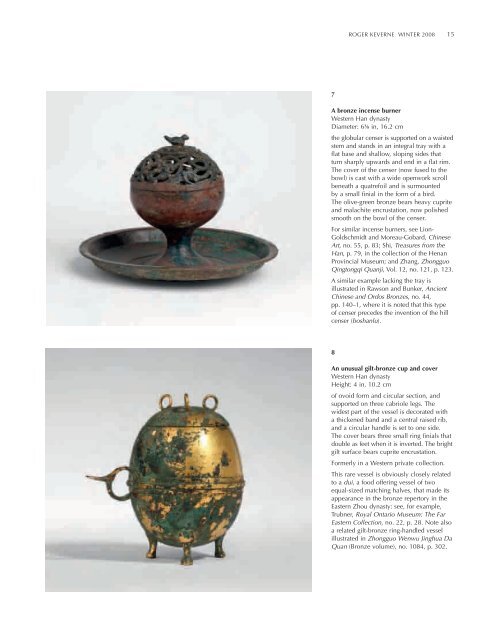WINTER EXHIBITION 2008 - Roger Keverne
WINTER EXHIBITION 2008 - Roger Keverne
WINTER EXHIBITION 2008 - Roger Keverne
You also want an ePaper? Increase the reach of your titles
YUMPU automatically turns print PDFs into web optimized ePapers that Google loves.
7<br />
ROGER KEVERNE <strong>WINTER</strong> <strong>2008</strong> 15<br />
A bronze incense burner<br />
Western Han dynasty<br />
Diameter: 6G in, 16.2 cm<br />
the globular censer is supported on a waisted<br />
stem and stands in an integral tray with a<br />
flat base and shallow, sloping sides that<br />
turn sharply upwards and end in a flat rim.<br />
The cover of the censer (now fused to the<br />
bowl) is cast with a wide openwork scroll<br />
beneath a quatrefoil and is surmounted<br />
by a small finial in the form of a bird.<br />
The olive-green bronze bears heavy cuprite<br />
and malachite encrustation, now polished<br />
smooth on the bowl of the censer.<br />
For similar incense burners, see Lion-<br />
Goldschmidt and Moreau-Gobard, Chinese<br />
Art, no. 55, p. 83; Shi, Treasures from the<br />
Han, p. 79, in the collection of the Henan<br />
Provincial Museum; and Zhang, Zhongguo<br />
Qingtongqi Quanji, Vol. 12, no. 121, p. 123.<br />
A similar example lacking the tray is<br />
illustrated in Rawson and Bunker, Ancient<br />
Chinese and Ordos Bronzes, no. 44,<br />
pp. 140–1, where it is noted that this type<br />
of censer precedes the invention of the hill<br />
censer (boshanlu).<br />
8<br />
An unusual gilt-bronze cup and cover<br />
Western Han dynasty<br />
Height: 4 in, 10.2 cm<br />
of ovoid form and circular section, and<br />
supported on three cabriole legs. The<br />
widest part of the vessel is decorated with<br />
a thickened band and a central raised rib,<br />
and a circular handle is set to one side.<br />
The cover bears three small ring finials that<br />
double as feet when it is inverted. The bright<br />
gilt surface bears cuprite encrustation.<br />
Formerly in a Western private collection.<br />
This rare vessel is obviously closely related<br />
to a dui, a food offering vessel of two<br />
equal-sized matching halves, that made its<br />
appearance in the bronze repertory in the<br />
Eastern Zhou dynasty: see, for example,<br />
Trubner, Royal Ontario Museum: The Far<br />
Eastern Collection, no. 22, p. 28. Note also<br />
a related gilt-bronze ring-handled vessel<br />
illustrated in Zhongguo Wenwu Jinghua Da<br />
Quan (Bronze volume), no. 1084, p. 302.


